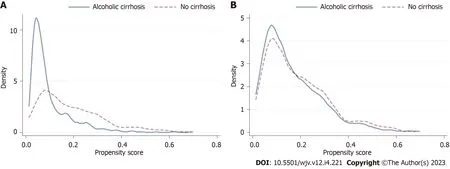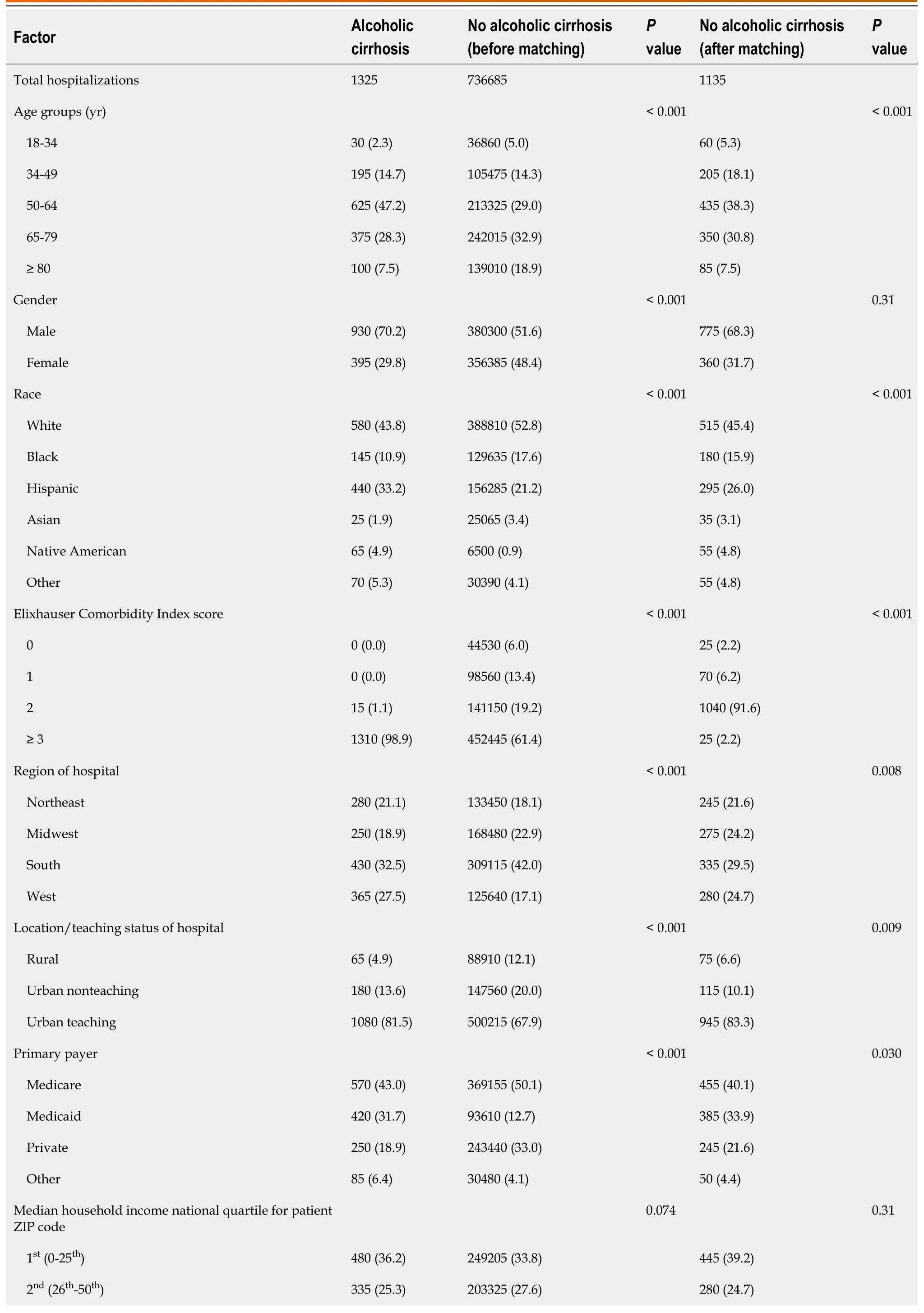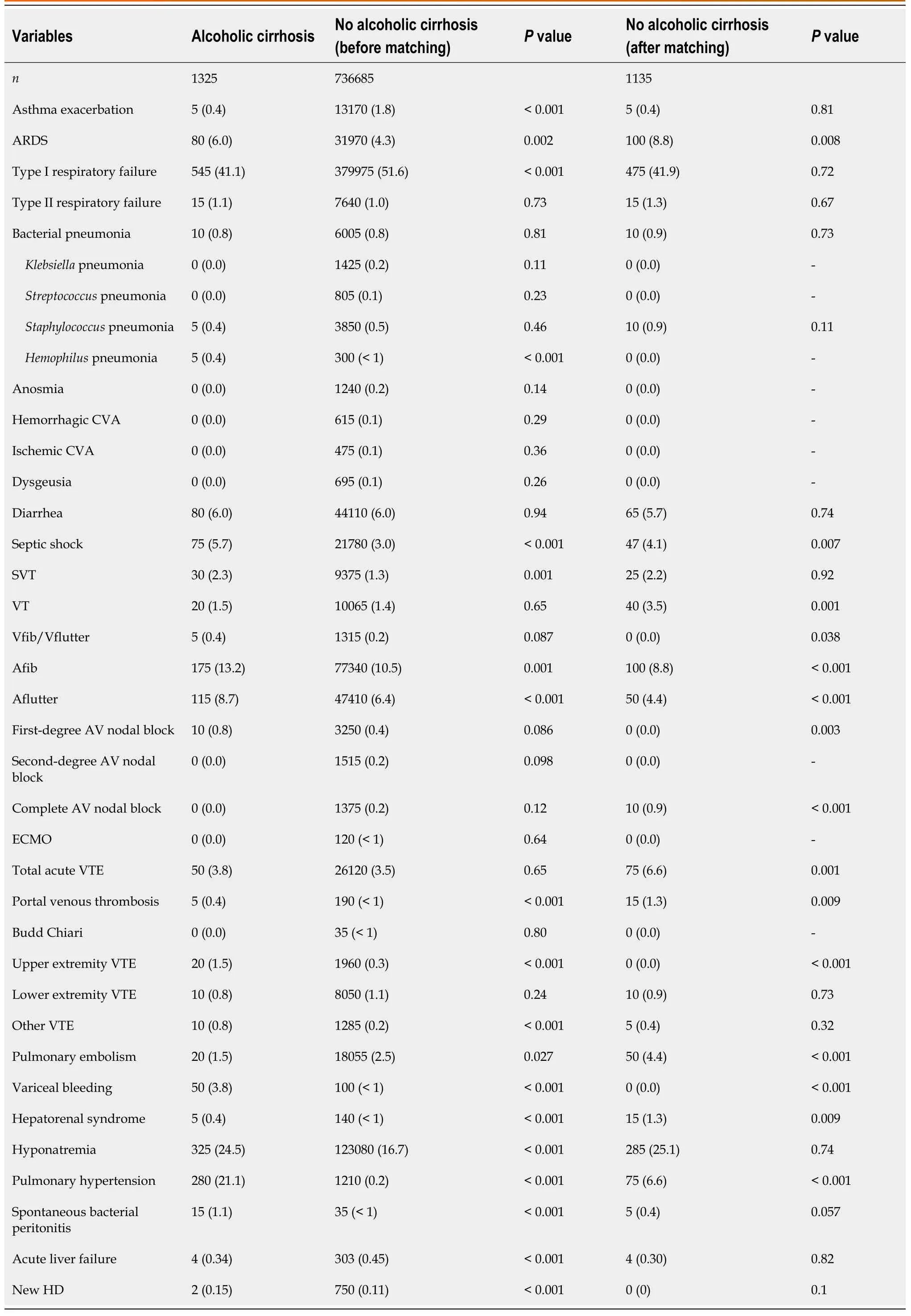Association between alcohol-associated cirrhosis and inpatient complications among COVID-19 patients: A propensity-matched analysis from the United States
Faisal Inayat,Hassam Ali,Pratik Patel,Rubaid Dhillon,Arslan Afzal,Attiq Ur Rehman,Muhammad Sohaib Afzal,Laraib Zulfiqar,Gul Nawaz,Muhammad Hassan Naeem Goraya,Subanandhini Subramanium,Saurabh Agrawal,Sanjaya K Satapathy
Abstract BACKGROUND Alcohol-associated cirrhosis (AC) contributes to significant liver-related mortality in the United States.It is known to cause immune dysfunction and coagulation abnormalities.Patients with comorbid conditions like AC are at risk of worse clinical outcomes from coronavirus disease 2019 (COVID-19).The specific association between AC and COVID-19 mortality remains inconclusive,given the lack of robust clinical evi-dence from prior studies.AIM To study the predictors of mortality and the outcomes of AC in patients hospitalized with COVID-19 in the United States.METHODS We conducted a retrospective cohort study using the National Inpatient Sample (NIS) database 2020.Patients were identified with primary COVID-19 hospitalizations based on an underlying diagnosis of AC.A matched comparison cohort of COVID-19 patients without AC was identified after 1:N propensity score matching based on baseline sociodemographic characteristics and Elixhauser comorbidities.Primary outcomes included median length of stay,median inpatient charges,and in-hospital mortality.Secondary outcomes included a prevalence of systemic complications.RESULTS A total of 1325 COVID-19 patients with AC were matched to 1135 patients without AC.There was no difference in median length of stay and hospital charges in COVID-19 patients with AC compared to non-AC (P > 0.05).There was an increased prevalence of septic shock (5.7% vs 4.1%),ventricular fibrillation/ventricular flutter (0.4% vs 0%),atrial fibrillation (13.2% vs 8.8%),atrial flutter (8.7% vs 4.4%),first-degree atrioventricular nodal block (0.8% vs 0%),upper extremity venous thromboembolism (1.5% vs 0%),and variceal bleeding (3.8% vs 0%) in the AC cohort compared to the non-AC cohort (P < 0.05).There was no difference in inpatient mortality in COVID-19 patients with non-AC compared to AC,with an odds ratio of 0.97 (95% confidence interval: 0.78-1.22,P=0.85).Predictors of mortality included advanced age,cardiac arrhythmias,coagulopathy,protein-calorie malnutrition,fluid and electrolyte disorders,septic shock,and upper extremity venous thromboembolism.CONCLUSION AC does not increase mortality in patients hospitalized with COVID-19.There is an increased association between inpatient complications among COVID-19 patients with AC compared to non-AC.
Key Words: Alcoholic cirrhosis;COVID-19;Chronic liver disease;Mortality predictors;Inpatient complications
INTRODUCTION
The global pandemic of coronavirus disease 2019 (COVID-19) has profoundly affected patients with pre-existing comorbidities.The World Health Organization reported that there were 768 million confirmed cases and 6.9 million fatalities as of June 21,2023[1].The disease presents a broad range of clinical features,from asymptomatic respiratory infection to severe pneumonia,thromboembolism,and even death.Initial reports from Wuhan indicated elevated serum liver biochemistry panels and associated liver injury in COVID-19 patients[2].Previous research has demonstrated that patients with chronic liver disease (CLD) had a longer disease duration and higher mortality after contracting COVID-19[3,4].CLD is a significant public health concern,with an estimated global burden of 1.5 billion patients and 2 million annual deaths[5].It is notable that viral hepatitis remains the leading cause of cirrhosis worldwide[6].However,obesity and alcohol use have emerged as critical risk factors following advances in the prevention and treatment of viral hepatitis[6].This etiological shift is expected to shape the future epidemiology of CLD[6].It can potentially make the hepatic involvement of COVID-19 particularly troubling for patients with underlying alcohol-associated cirrhosis (AC)[7].
Patients with cirrhosis often develop immunological perturbations,leading to systemic inflammation and immune deficiency[8].This immune dysfunction could potentially make it more difficult for cirrhotics to fight COVID-19.Numerous studies have identified an increased risk of COVID-19 severity and death in cirrhotic patients[9-11].However,the literature offers conflicting results regarding the clinical impact of underlying cirrhosis on COVID-19 outcomes.For instance,Bajajetal[12] reported similar mortality rates between cirrhotics with and without COVID-19,yet highlighted higher mortality in cirrhotics compared to patients suffering from COVID-19 alone.Moreover,the COVID-19-associated mortality rates in patients with CLD and cirrhosis varied from 8.9% to 39.8%[13,14].
Based on available clinical epidemiologic studies,there is a limited understanding of the etiologic basis of the clinical outcomes of cirrhosis in patients with COVID-19.However,several studies have investigated this subject.For example,in a single-center retrospective analysis of a cohort of patients hospitalized for COVID-19 with a prevailing alcoholic CLD,liver cirrhosis was linked to a fourfold increase in 30-d mortality[15].A Korean study suggested that people with underlying nonalcoholic fatty liver disease may be more likely to test positive for severe acute respiratory syndrome coronavirus type 2 (SARS-CoV-2) and experience severe infection[16].In addition,Kimetal[17] conducted a multicenter,observational cohort study demonstrating increased overall mortality in patients with CLD and COVID-19 due to alcohol-associated liver disease,decompensated cirrhosis,and hepatocellular carcinoma.
Our objective is to assess the impact of AC on outcomes and mortality in patients hospitalized with COVID-19 using a large,multicenter database.We also seek to identify mortality predictors in COVID-19 patients with AC.To our knowledge,this is the first study to examine the specific clinical influence of AC on COVID-19 by assessing substantial epidemiological trends in hospitalized patients in the United States.
MATERIALS AND METHODS
Design and data source
This retrospective cohort study is reported according to the Strengthening the Reporting of Observational Studies in Epidemiology guidelines[18].We utilized the recently released National Inpatient Sample (NIS) database 2020.It is designed by the Agency for Healthcare Research and Quality[19].NIS is the largest inpatient database in the United States healthcare system[19].The design of this database enables the calculation of national estimates using sampling weights and a 20% stratified sample of hospitals[19].Detailed information on the design of NIS and sampling methods is available at https://www.hcup-us.ahrq.gov.NIS 2020 utilized the International Classification of Diseases (ICD) 10 coding system to store and report data.We identified hospitalizations with a primary diagnosis (DX1) of COVID-19 using the“U07.1” ICD-10 code,which was introduced in March 2020[20].Hospitalizations were excluded if the patient age was <18 years,individuals were transferred,and/or COVID-19 was listed as a secondary diagnosis.Furthermore,patients were excluded if there was any history of cirrhosis due to nonalcoholic and other causes (viral,autoimmune,or non-specified),hepatocellular carcinoma,malignant neoplasm,end-stage renal disease requiring dialysis,quadriplegia,lymphoma,renal transplant,or liver transplant,as these were deemed high-risk conditions that could confound our analysis.
Outcome measures
Primary outcomes included median length of stay,median inpatient charges,and in-hospital mortality.Secondary outcomes included a prevalence of respiratory,cardiac,circulatory,neurological,and renal complications.
Statistical analysis
Statistical analysis was performed using Statistical Software for Data Science (StataCorp LLC,College Station,TX,United States) version 16.0.Two cohorts were created based on the presence or absence of a secondary diagnosis of AC using ICD-10 codes employed in the published literature[21].We developed matched cohorts using propensity score matching(PSM) to minimize the effect of comorbid imbalances between comparison cohorts.Each case was assigned a propensity score using a multivariable logistic regression that included baseline sociodemographic characteristics (age,sex,race,socioeconomic status,and Elixhauser comorbidities).Propensity scores between the two cohorts were matched in a 1:N fashion using the nearest-neighbor method within 0.01 standard deviations of the calculated score[22].The covariate balance was then visualized using the two-way plot (Figure 1).A two-sample Wilcoxon rank-sum (Mann-Whitney) test was utilized for continuous variables.The Chi-square test was used to compare categorical variables.The significance threshold was set atP< 0.05.For logistic regression,hierarchical models were designed using any unbalanced variables in PSM (race).The positive mortality predictors were then used to build a final multivariate model.Only significant positive predictors of mortality were reported as odds ratios (OR) with 95% confidence intervals (CI) andPvalues.

Figure 1 Two-way plot visualizing the covariate balance in our study.A: Before matching;B: After matching.
Ethical considerations
The NIS is a de-identified hospital-level,third-party database.The privacy of patients,clinicians,and medical centers is protected by its design.Patient consent was waived as the hospitalization data were stripped of any patient identifiers.The approval of the institutional review board (IRB) was not required for this study.
RESULTS
A total of 738010 primary COVID-19 hospitalizations fulfilled the selection criteria and were included in the study.A total of 1325 hospitalizations with AC were matched to 1135 without AC using nearest-neighbor matching (Table 1).The age group 50-64 years had a higher prevalence in the AC cohort than the non-AC cohort (P< 0.001).The median age was 60 years,with an interquartile range (IQR) of 54-67 in the AC cohort and 61 years (IQR: 54-67) in the non-AC cohort.There was no disparity based on gender (P=0.31).Hispanics (33.2%vs26.0%) and Native Americans (4.9%vs4.8%) had a higher prevalence in the AC cohort compared to the non-AC cohort (P< 0.001).There was a higher prevalence of an Elixhauser Comorbidity Index (ECI) score ≥ 3 (98.9%vs2.2%) in the AC group compared to the non-AC group (P< 0.001).Mortality was significantly higher in hospitalizations with non-AC compared to AC (15.0%vs14.7%,P=0.024).Disposition was more likely to be against medical advice if there was a secondary diagnosis of AC compared to non-AC(3.8%vs3.5%,P=0.024).There was no difference in intensive care unit (ICU)-level care (10.6% each,P=1.00).There was no significant difference in median length of stay or median hospital charges between the AC and non-AC groups (P>0.05).

Table 1 Baseline biodemographic characteristics of hospitalized coronavirus disease 2019 patients with and without alcoholassociated cirrhosis,n (%)
There was an increased prevalence of septic shock (5.7%vs4.1%),ventricular fibrillation/ventricular flutter (0.4%vs0%),atrial fibrillation (13.2%vs8.8%),atrial flutter (8.7%vs4.4%),first-degree atrioventricular nodal block (0.8%vs0%),upper extremity venous thromboembolism (VTE) (1.5%vs0%),variceal bleeding (3.8%vs0%),and pulmonary hypertension (21.1%vs6.6%) in the AC cohort compared to the non-AC cohort (P< 0.05) (Table 2).The additional comorbidity burden in the matched cohort is outlined in Supplementary Table 1.AC had no significant association with acute kidney injury (OR 0.89,95%CI 0.74-1.07,P=0.23) or acute liver failure (OR=0.97,95%CI: 0.21-4.34,P=0.91).

Table 2 Inpatient outcomes of coronavirus disease 2019 patients with and without alcohol-associated cirrhosis,n (%)
On multivariate regression,significant predictors of mortality for the matched cohort included cardiac arrhythmias(OR=2.34,95%CI: 1.38-3.97,P=0.002),coagulopathy (OR=1.87,95%CI: 1.28-2.73,P=0.001),protein-calorie malnutrition (OR=5.96,95%CI: 3.67-9.68,P< 0.001),fluid and electrolyte disorders (OR=1.56,95%CI: 1.05-2.32,P=0.027),septic shock (OR=18.77,95%CI: 10.02-35.13,P< 0.001),atrial fibrillation (OR=2.01,95%CI: 1.11-3.63,P=0.020),upper extremity VTE (OR=11.38,95%CI: 3.65-35.46,P< 0.001),and increasing age (OR=1.06,95%CI: 1.04-1.07,P< 0.001)(Table 3).

Table 3 Inpatient mortality predictors for coronavirus disease 2019 patients with alcohol-associated cirrhosis (after matching)
DISCUSSION
This national population-based study evaluated hospitalized COVID-19 patients with and without AC according to age,gender,and race to identify high-risk individuals.Our findings indicate that AC does not significantly increase mortality among patients hospitalized with COVID-19.However,it is associated with a higher prevalence of inpatient complications,particularly in certain demographic groups and people with higher ECI scores.Interestingly,despite these complications,there was no significant difference in the need for ICU-level care,length of stay,or hospital charges between the AC and non-AC groups.
Alcohol consumption increased during the COVID-19 pandemic due to isolation and social distancing protocols[23].A study conducted in the United States analyzed changes in adult alcohol consumption during the pandemic[24].It reported a 14% increase in the frequency of alcohol use[24].The median age group in their analysis that saw increased alcohol consumption was similar to the median age in our AC cohort (IQR: 54-67).The increase in alcohol intake during the COVID-19 pandemic in this age group might have aggravated the disease burden of AC[24].A multicenter study in the United States reported that Hispanic ethnicity and decompensated cirrhosis were associated with a higher risk for severe COVID-19[17].In our data,we also observed a higher prevalence of Hispanics in the AC cohort than in the non-AC cohort.It is known that increasing age reduces the ability to metabolize alcohol due to decreased mitochondrial function[25].Upon multivariate analysis of our data,we identified increasing age as a mortality predictor among COVID-19patients with AC.The clinical symptoms between the younger and older age groups might be similar in the presence of AC.However,the elderly tend to develop more complications due to a decline in the robustness of the immune system.In a study conducted at the Johns Hopkins Health System,Krishnanetal[26] showed that increasing age and hepatic decompensation were associated with all-cause mortality among COVID-19 patients with CLD.
In our analysis,the mortality rates were comparable in both the AC and non-AC cohorts.One potential explanation could be that during the COVID-19 pandemic,only the most critically ill cirrhotic patients were admitted,rendering the presence of infection negligible in impacting the clinical outcome.Moreover,comorbidities among AC patients with higher ECI scores could affect the mortality rate.This might have resulted in similar ICU admission rates in both AC and non-AC cohorts.Intriguingly,our data showed that more non-AC patients received mechanical ventilation than AC patients.This is noteworthy because it may indicate an attempt to avoid mechanical ventilation,which is commonly regarded as a predictor of death in cirrhosis[10].Shalimaretal[27] showed in their study that the need for mechanical ven-tilation independently predicted mortality in CLD patients with COVID-19.
Cirrhosis-associated immune dysfunction is characterized by systemic inflammation and impaired immunocompetence[28].The dysregulated complement factors,immunoglobulins,and acute-phase proteins may correlate with cirrhosis severity and can serve as biomarkers of immune alterations in these patients[28].These dysregulations expose cirrhotics to an increased risk of infections and liver-related death[28].Bolarínetal[29] revealed that sepsis was the leading cause of non-sudden death in patients with AC ten years after liver transplantation.Guerra Velozetal[30]showed that hospitalized COVID-19 patients with CLD required almost four times more antibiotic therapy compared to those without CLD.Similar findings were observed in another study,which demonstrated that cirrhotics had an increased risk of mortality,organ dysfunction syndrome,superinfections,and greater influenza severity compared to non-cirrhotics[31].These observations may explain why a higher prevalence ofHemophiluspneumonia,septic shock,and spontaneous bacterial peritonitis was observed among AC patients in our study.
Patients with cirrhosis often develop portal hypertension.It frequently leads to upregulation of angiotensin-converting enzyme 2 (ACE-2) to counteract this major complication of cirrhosis[32].This makes patients with AC more susceptible to COVID-19 infection,as ACE-2 is the critical functional receptor for SARS-CoV-2[33,34].Therefore,it could possibly be associated with inpatient complications and a poor prognosis.During the pandemic,hospital stays for patients with cirrhosis were shorter,and more of these patients were discharged to go home compared to the pre-COVID era.Similarly,we observed a higher proportion of AC patients discharged home than non-AC patients in our study.This trend reflects the drive to conserve inpatient resources and promote home isolation unless the patient requires urgent medical treatment.However,it might have increased the risk of early post-hospital discharge mortality in patients with decompensated cirrhosis during the COVID-19 period[35].A United States national cohort study using data from the Veterans Health Administration reported a decrease in hospitalizations of cirrhotic patients during the pandemic from January to April 2020[36].Contrarily,in line with the increase in alcohol consumption during the early phase of thepandemic,we might foresee a rise in long-term morbidity and mortality related to alcohol-associated liver disease[37].Therefore,AC hospitalizations may increase in the future,requiring high-level hepatology care and follow-up.
In patients with cirrhosis,the risk of developing VTE is significantly increased due to the reduced ability to synthesize anticoagulation factors[38].In line with these findings,we also noted a higher prevalence of VTE in the AC cohort.In addition,the presence of VTE was identified as a mortality predictor.Therefore,cirrhotic patients should undergo a caseby-case consideration of thromboprophylaxis for deep vein thrombosis[39].Another significant variable observed in our data was the higher prevalence of atrial fibrillation among the AC cohort.A nationwide study conducted in Korea demonstrated a 46% increased risk of developing atrial fibrillation in cirrhotic patients compared to the non-cirrhotic control group[40].Furthermore,with COVID-19 in these patients,there is a higher chance of observing electrocardiographic abnormalities.In a systematic review,a fourfold higher risk of death was reported among COVID-19 patients with atrial fibrillation[41].This finding overlaps with our data,where atrial fibrillation was also identified as a mortality predictor.Upon multivariate analysis,we also identified cardiac arrhythmias and coagulopathy as mortality predictors for the AC cohort.Therefore,cirrhotic patients must be carefully monitored before being discharged home to prevent such serious complications.Notably,the clinical management of cirrhotics with COVID-19 is complicated because most pharmacological agents are metabolized by cytochrome P450 monooxygenases in the liver[42].Therefore,patients with COVID-19 may have a higher risk of developing hepatotoxicity in the presence of CLD due to drug-drug interactions[42].This might have contributed to the overall ICU admission rate reported in the AC cohort in our study.
Recent research revealed several associations between SARS-CoV-2 infection and medical conditions that may lead to liver dysfunction[43].Moreover,studies have demonstrated that there is an increased risk of decompensation and mortality in COVID-19 patients with pre-existing cirrhosis[44].This can possibly be attributed to cirrhosis-related immunological modulation,insufficient physiological reserves,and an increased risk of severe COVID-19 disease[43,44].The underlying mechanism of liver injury secondary to COVID-19 is multifactorial.SARS-CoV-2 may induce direct hepatotoxicityviacholangiocytes,translocation from the gut to the liver,or indirect liver damage from systemic inflammation,hypoxia,ischemic insult,or drug-induced liver injury[44].While the expression of ACE-2 receptors on hepatocytes has been reported,a substantial contribution from indirect causes of liver injury has been described in COVID-19 patients[44].Furthermore,treating severe COVID-19 infection with certain antiviral agents,immunomodulators,and supportive agents may also cause hepatotoxicity[44].Large registries report a case fatality rate of 38%,rising to 70% in the Child-Pugh C category[7,44].These findings highlight the need for vigilant pharmacological management.Further research is warranted to evaluate the pathological interplay between AC and COVID-19.It is particularly important to understand the mecha-nisms of liver injury and the impact of COVID-19 on pre-existing liver disease.
Our retrospective study is one of the largest to evaluate the specific clinical impact of AC on COVID-19 hospitalizations.We analyzed the patient outcomes based on comorbidities,mechanical ventilation,ICU admission,and mortality predictors.Given the critical nature of the disease association,a multidisciplinary approach is required to manage hospitalized COVID-19 patients with AC.This study will provide invaluable information with regard to identifying high-risk patients and monitoring the factors associated with the rising prevalence of AC.One of the major strengths of this study is the detailed comparison between COVID-19 patients with and without AC.This allows for a better understanding of the variables associated with mortality among the two cohorts.
Limitations
We acknowledge certain limitations to our study.The ICD-10 coding system may present inaccurate data when utilizing a large database like NIS,which may potentially skew the analysis.In addition,the NIS data might only be representative of those hospitals participating in the Healthcare Cost and Utilization Project[45].The information regarding severity of the disease or treatment is not provided in the NIS database.The COVID-19 waves varied from state to state within the United States.Hence,some areas were more heavily impacted than others.Upon analysis of geographical regions in our data,urban teaching hospitals had a greater number of patients with AC.A nationwide study of hospitalized patients in the United States identified urban hospitals as being associated with a greater risk of infection in cirrhotic patients[46].These infections included sepsis,pneumonia,and spontaneous bacterial peritonitis[46].Therefore,the mortality rate might be higher,especially in urban hospitals.Moreover,it can be difficult to diagnose chronic non-AC as COVID-19 may lead to abnormalities in liver function testing in hospitalized patients[47,48].
CONCLUSION
This study has thoroughly analyzed the influence of AC on COVID-19 hospitalizations.Our results indicate that the presence of AC does not significantly impact mortality in COVID-19 patients,warranting further evaluation in a larger cohort.Interestingly,despite the higher ECI scores among the AC cohort,the length of stay and ICU admission rates were comparatively similar across the non-AC cohort.Advanced age was found to be a predictor of death in patients with AC,along with other variables like cardiac arrhythmias,coagulopathy,protein-calorie malnutrition,fluid and electrolyte disorders,septic shock,and upper extremity VTE.Due to the multifactorial nature of hepatic injury in COVID-19,further research will be required to evaluate effective pharmacological treatments in COVID-19 patients with AC.Despite the fact that COVID-19 transmission has slowed down,identifying high-risk groups early on is important.It will make it more convenient for hospitalized COVID-19 patients with AC to receive a tailored medical treatment that could improve their prognosis.
ARTICLE HIGHLIGHTS
Research background
Patients with chronic liver disease (CLD) may be at risk of adverse outcomes following coronavirus disease 2019 (COVID-19).Initial findings from Wuhan indicated potential liver injury in COVID-19 patients.With the growing role of obesity and alcohol,understanding the specific implications of alcohol-associated cirrhosis (AC) for patients with COVID-19 is of paramount clinical importance for prognostication and appropriate therapeutic strategy.
Research motivation
Cirrhosis is typically associated with immune system impairments,which might hinder the ability of patients to combat COVID-19.While several studies have indicated an increased risk of COVID-19 severity in cirrhotic patients,the specific impact of AC on inpatient outcomes remains incompletely defined.
Research objectives
This study primarily aims to assess the impact of AC on inpatient outcomes and mortality rates in patients hospitalized with COVID-19 compared to those without AC.Furthermore,we intend to identify predictors of mortality within the COVID-19 patient cohort with AC.
Research methods
A retrospective cohort study was conducted using the National Inpatient Sample database 2020,focusing on hospitalizations with a primary diagnosis of COVID-19.Two cohorts were established based on the presence or absence of AC.Propensity score matching was used to compare the cohorts and a range of statistical analyses were applied to the data.
Research results
Of the 738010 patients hospitalized with COVID-19 that fulfilled the selection criteria,1325 with AC were compared to 1135 without AC.It was found that AC did not significantly increase mortality in COVID-19 patients.However,it was linked to a higher prevalence of inpatient complications,especially in certain demographics and those with higher Elixhauser Comorbidity Index scores.
Research conclusions
AC does not increase mortality rates in the context of COVID-19 hospitalizations.However,it is associated with a heightened prevalence of certain inpatient complications.Despite these systemic complications,there was no noticeable difference in intensive care unit requirements,length of stay,or hospital charges between AC and non-AC groups.
Research perspectives
This research provides valuable insights into the implications of AC for COVID-19 patients.It prompts clinicians to conduct future research and delve deeper into understanding the exact mechanisms leading to these complications in COVID-19 patients with AC.Exploring preventive measures or pharmacological treatment adjustments for this vulnerable population may improve patient outcomes.
FOOTNOTES
Author contributions:Inayat F,Ali H,Patel P,Dhillon R,and Afzal A concepted and designed the study,participated in the acquisition of data,interpretation of results,writing of the original draft,and critical revisions of the important intellectual content of the final manuscript;Rehman AU,Afzal MS,Zulfiqar L,Nawaz G,Goraya MHN,Subramanium S,and Agrawal S contributed to the analysis and interpretation of results and drafting of the manuscript;Satapathy SK reviewed,revised,and improved the manuscript by suggesting pertinent modifications;and all authors critically assessed,edited,and approved the final manuscript and are accountable for all aspects of the work.
Institutional review board statement:The data of patients was not acquired from any specific institution but rather open-access United States National Inpatient Sample (NIS) database.The NIS contains de-identified information,protecting the privacy of patients,physicians,and hospitals.Therefore,it was deemed exempt from the institutional review board.
Informed consent statement:Participants were not required to give informed consent for this retrospective cohort study since the analysis of baseline characteristics used anonymized clinical data.
Conflict-of-interest statement:All the authors report no relevant conflicts of interest for this article.
Data sharing statement:No additional data are available.
STROBE statement:The authors have read the STROBE Statement-checklist of items,and the manuscript was prepared and revised according to the STROBE Statement-checklist of items.
Open-Access:This article is an open-access article that was selected by an in-house editor and fully peer-reviewed by external reviewers.It is distributed in accordance with the Creative Commons Attribution NonCommercial (CC BY-NC 4.0) license,which permits others to distribute,remix,adapt,build upon this work non-commercially,and license their derivative works on different terms,provided the original work is properly cited and the use is non-commercial.See: https://creativecommons.org/Licenses/by-nc/4.0/
Country/Territory of origin:United States
ORCID number:Faisal Inayat 0000-0001-7576-7319;Hassam Ali 0000-0001-5546-9197;Pratik Patel 0000-0003-1375-8542;Sanjaya K Satapathy 0000-0003-0153-2829.
S-Editor:Wang JJ
L-Editor:A
P-Editor:Wang JJ
 World Journal of Virology2023年4期
World Journal of Virology2023年4期
- World Journal of Virology的其它文章
- Performance evaluation of NeuMoDx 96 system for hepatitis B and C viral load
